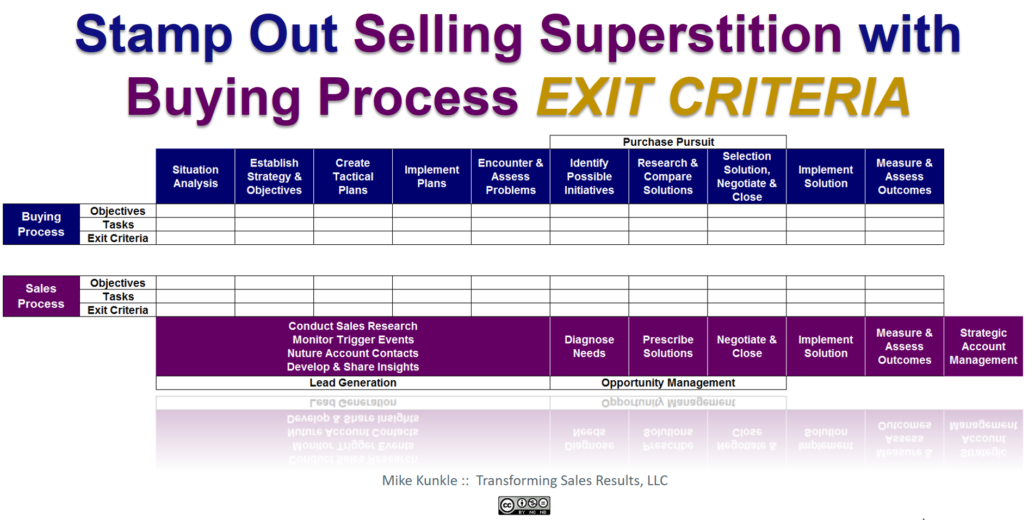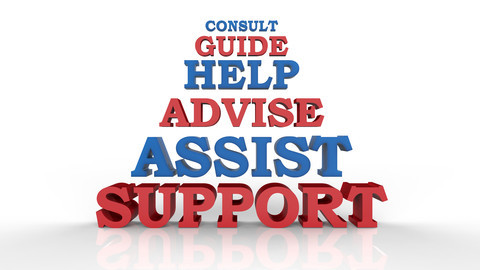Stamp Out Selling Superstition with Buying Process Exit Criteria

“Always be closing… That doesn’t mean you’re always closing the deal, but it does mean that you need to be always closing on the next step in the process.”
This is probably obvious, but before you panic from thinking that I’ve suddenly become an ABC fan and am sitting in a Cadillac with a set of steak knives watching a DVD of Alec Baldwin, Shane is just referring to professionally gaining commitment to move forward to the next step (and possibly the next stage) of the buying/sales process.
In essence, boiled down to it’s core, selling is simply gaining a series of commitments that lead to a purchase. Buyers, like all of us who shop for things, have a process they go through to make a decision. Likewise, sellers (should) have a process they follow to sell their products/services/solutions (which hopefully maps to what their buyers are doing).
Suddenly, Process is Popular
With that said, we’re hearing more and more about sales process these days, aren’t we?
Multiple sources have published studies indicating that companies with a defined sales process perform better:
- https://hbr.org/2015/01/what-top-sales-teams-have-in-common-in-5-charts
- http://smartsellingtools.com/velocify-study/
- https://hbr.org/2015/01/companies-with-a-formal-sales-process-generate-more-revenue
Many others in the sales and marketing community have been blogging about sales process:
- http://blog.hubspot.com/sales/sales-process-or-sales-methodology
- http://blog.hubspot.com/sales/sales-methodology-magic-or-madness
- https://blog.kissmetrics.com/effective-sales-process/
- http://thesalesblog.com/blog/2015/03/17/share-your-sales-process-with-your-prospect/
- http://www.salesbenchmarkindex.com/bid/80407/Crossing-the-Sales-Process-Chasm-The-Major-Interaction
My esteemed industry colleague, Michael Webb of Sales Performance Consultants, Inc., has recently published a $75.00 tome on the topic (it’s worth every penny and his work has received due recognition):
And finally, the importance of aligning with the buying journey is getting far more press:
- http://www.dsgconsulting.com/ebooks/posts/buying-process-as-sales-enablement-framework
- http://www.salesbenchmarkindex.com/bid/93934/How-to-Spot-Where-Your-Customer-is-on-Their-Buyer-s-Journey
- http://www.b2bknowledgesharing.com/2013/12/02/why-sales-might-have-a-hard-time-with-the-buyer-journey/
These are only a smattering of posts and resources, are all worth reading, and are simply meant as examples of the growing body of work on sales process.
This is all great news, right?
For those nodding, “Yes,” I agree. Yet, while there is a lot more attention being paid to the need for sales process work, much of what I read is very high level (i.e., “you should follow a sales process,” “companies that use a sales process perform better,” and “here’s what a sales process looks like”). I’m not a fan of generalizations and don’t mean to paint everyone with that brush, but I think those who haven’t done much with process work need more detail and better examples. It’s tough in a short (or even long) blog post to do this, though, so I acknowledge the challenges and face them myself.
For that reason, I’d like to focus in this post on one small yet powerful piece of the buying process, and how we as sales professionals can use it, to reduce what I call “Selling by Superstition” and improve our sales effectiveness. That gold nugget is… Buying Process Exit Criteria.
Buying Process Exit Criteria 
So what are exit criteria, in this context? They are the measures used to determine if the tasks within the process stage have been completed and whether the objectives of that stage have been met, so the buyer can move forward.
Here’s a quick example of what I mean:
SCENARIO:
Imagine a buyer has encountered an issue that is preventing them from executing the tactical plans that support their strategy. Naming conventions vary, but they’e in a stage I call “Encounter and Assess Problems.” What do you think the tasks and exit criteria for this stage might include? Perhaps they would be:
TASKS:
- Assess Situation: They have assessed the issue and at least to their satisfaction, have clearly identified and documented the root cause problem that is holding them back. They realize, to some degree, what is it costing them to not solve the issue.
- Explore Problem-Solving: They have some idea of what the solution(s) may be.
- Realize Limitations: They recognize additional expertise is required or have assessed that it isn’t something they can address quickly enough internally… they need outside expertise and help.
- Decide to Explore Options: They’re ready to explore options and define an initiative that will help them address the issue.
EXIT CRITERIA:
- The issue, possible causes, and business requirements are defined and documented.
- A decision has been made to seek external assistance in resolving the issue.
Make sense?
If this is old news, I apologize for hanging here for a minute, but for those for whom this is a new thought, especially for reps who have been solely focused on what they do and their sales process, this could be an important Aha Moment.
And even for those who know this concept well… let me ask you something.
“When was the last time you asked a buyer of yours if their team’s criteria for the current stage had been satisfactorily met, before trying to gain commitment to move forward?”
Or, how many times did you absolutely know those criteria in advance, as you were moving into the stage you’re in now? Reality being what it is, I don’t expect to hear many “100 percent of the time, Mike!” answers, because not everyone is as transparent as we’d all hope. But it ought to be pretty high. For the bulk of the pipeline-stalled deals that are actually real opportunities, I’d contend that this is one of the primary culprits.
A Framework for Guiding the Purchase/Sale
Here’s a simple framework that will help you with this. You may agree or disagree with the processes (stages and names) as they’re mapped here in this example — that’s not the point. While there are commonalities, buying and sales processes vary. In my opinion, there are elements of the sales process that map directly to the buying process, but not all stages align exactly or occur linearly – especially in the early stages or “Top of the Funnel” in Lead Generation.
So, rather than derailing on possible differences between my example and your reality, hone in on these things, instead:
- There are Processes and Process Stages for both buying and selling
- At a minimum, the Opportunity Management process for sellers aligns with the Purchase Pursuit process for buyers
- Each process stage has Objectives, Tasks to be completed, and Exit Criteria (outcomes) that designate that the stage is complete
If you document your buyer’s journey and processes, objectives, tasks and exit criteria, it’s very illuminating. As you do that, ask yourself:
- Process: For my typical customers, how to they do go about making a purchase? What stages do they go through?
- Objectives: What do buyers need to accomplish in each stage? What are their goals?
- Tasks: What steps will they take to accomplish those objectives?
- Exit Criteria: How will they know when they’re done and ready to move forward? What needs to be completed in each stage? Beyond task achievement, there is another critical element to exit criteria in a buying process… it’s also decision criteria. These are the things that each buyer must see, hear, feel, understand and believe, in each stage, to feel comfortable moving forward to the next stage, with you. Make no mistake — these criteria can vary for each buyer in your opportunity. This is what makes “the complex sale” complex.
Knowing these Exit Criteria (generally, at the persona level) and confirming them with your real buyers (specifically, at the person level), gives you a clear road map, around which you can build your plan and approach. That clarity, and your close sync with your buyers, can’t help but increase your effectiveness, as a seller.
Note: I’d recommend doing this along with Buyer Persona work that includes the various roles who are involved in the decision, along with the factors these buyers consider during a purchase (including emotional factors and other pressures, like politics). Some of this can be difficult to map generically, so if you can’t do that, remember these elements when you’re working with a real opportunity and a real set of decision makers. (And, if possible, hire a persona expert, to help you get it all right.)
A Chance to Always Be Helping, Too 
Let’s be honest. Are all your buyers this organized? Do organizations always have a well-defined buying process with defined stages, objectives, and tasks, with outcomes or exit criteria defined? One can hope, but I can almost hear you laughing from here. I know this varies based on many factors, including the size of the organization, the maturity of the company, and/or the competence of the buyers. While it’s troubling that not everyone will have things this defined, make no mistake that there is some way that things get done in their culture, even if employees absorb it through osmosis. When there is a lack of organized buying process, this gap also provides you with a real opportunity to introduce a logical thought process, ask great questions, and provide some structure for your buyers — not only to help them work through the process, but perhaps also to help them look good inside their own organization.
For example, in my Four Pillars of Sales Value Creation work, I talk about Operational Acumen, which I’ve seen top sales producers exhibit for years. This is an understanding of how things get done in organizations, not only their own, but in others. It’s not only which roles do what, but the players, their influence, politics, culture, and how things “really get done around here.” Top reps assess this quickly and respond appropriately. Thinking through the recommendations in this post can help you improve your Operational Acumen, and perhaps help your buyers as well.
_____________________________________________________________
Well, that’s it for this post on Buying Process Exit Criteria. As usual, this is what I think. More importantly, what do YOU think?
I’d enjoy hearing your thoughts in the comments. I’ve also included some related reading below, that I hope you’ll find helpful.
Thanks for reading, be safe out there, and by all means — let’s continue to elevate our sales profession and evolve, elevate and professionalize the Sales Enablement function.
Mike Kunkle
Get connected / follow my content:
- Blog: https://www.mikekunkle.com/blog
- LinkedIn Publisher Posts: My LinkedIn Posts
- Sales Transformation Straight Talk Webinars: http://bit.ly/STSTonSMM
- The Sales Experts Channel Webinars: http://bit.ly/SalesExpertsChannel
- LinkedIn: https://www.linkedin.com/in/mikekunkle
- Twitter: https://twitter.com/mike_kunkle
- SlideShare: http://www.slideshare.net/mikekunkle



